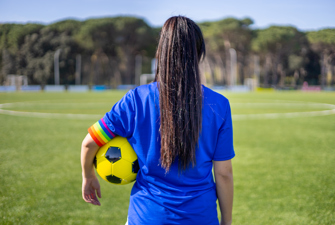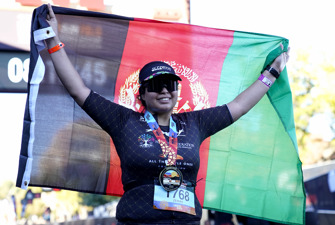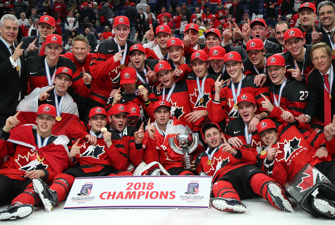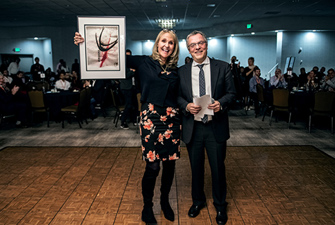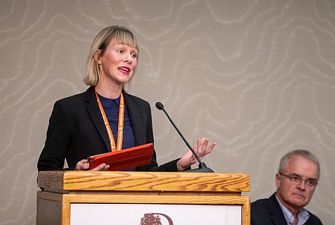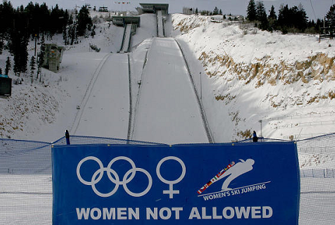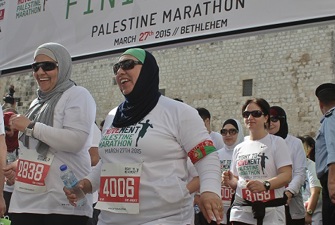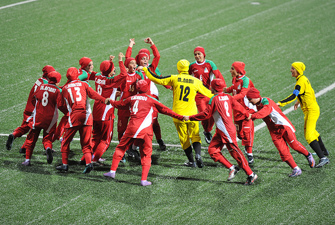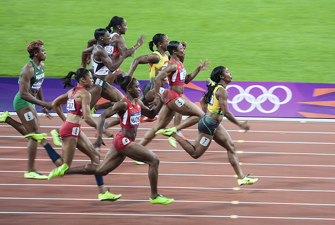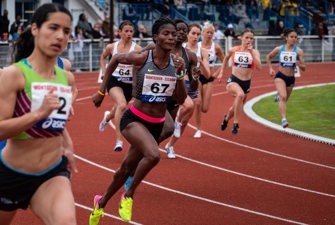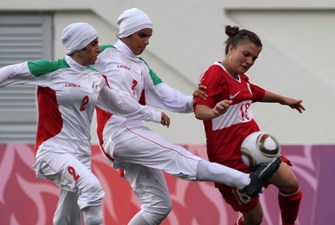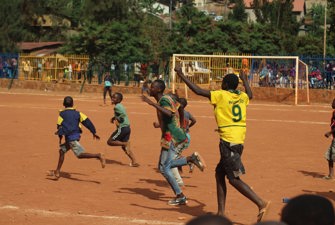Sexual Stereotypes in Sport - Experiences of Female Soccer Players
"In my community many believe that everyone who plays soccer in my club is a lesbian". This quote is from a Norwegian top level female soccer player.
Now, - so what? - one may ask, why was this player who, like most of her female team-mates, happened to be heterosexual, so upset when she told this to me? The answer is that it has something to do with the fact that lesbians are looked down upon in our society. To be gay or lesbian still has a negative connotation, and historically there are many example of very bad treatment toward people who are hot hetersexual.
This again is related to the fact that we live in a o homophobic and homonegative society. Now, what is homonegativism and homophobia? What does these words mean? Homophobia is defined as: the irrational fear and intolerance of homosexuality, gay men or lesbians, - and even behavior that is perceived to be outside the boundaries of traditional gender role expectation. Homonegativism is a more inclusive term, describing purposeful, not irrational, negative attitudes and behaviors toward non heterosexuals. Now, with reference to the theme of this session, I will try to outline what this has to do with health and sport.
Sport has been developed by and for men, and even today is ruled by men to a large extent. An excellent example of this is the IOC, even thought they now have reached their goal, having 10 % female members. Of the 106 national Olympic committees, five have female presidents. Out of the 34 international sport federations that participate in the Olympic Games two are led by a woman. The development of women's sport has been dramatic during the last 20 years. Women are now competing in sports which traditionally have been looked upon as very masculine and from which for many years they were not allowed to participate in. Sport is however still considered a masculine domain in our society. It is very clear that the institution of sport promotes compulsory heterosexuality (i.e. expectations and acceptance of heterosexuality as the only appropriate sexual orientation.) This also has some dramatic consequences for female athletes who must feel a pressure to conform to a heterosexual image, which becomes very clear to us through the media presentations.
According to David Whiston, a famous sport sociologist from Canada, sport has historically been an arena where men have reinforced their masculinity and emphasized their differences from women. An interesting question is therefore what happens when many more women enter the world of sport, not only as athletes, but also as presidents, coaches and sport editors. That is another speech. The point I want to make here is that the world of sport, read the men's world of sport may be threatened. Men will loose power, and one way of reacting to this loss of power is with anxiety and fear. This is also one of the explanations given for homophobia, because it is very difficult for men to have power over lesbian women. But since the definition of homophobia also includes an "irrational" fear of behavior that is perceived to be outside the boundaries of traditional gender expectations, you understand why many heterosexual female athletes also suffer from homo negativism. They have entered a "male" playing field. If this is a sport which traditionally has been defined as "masculine", or the female athlete's appearance differs from a feminine stereotype, the chance that she are labeled "lesbian" is even larger. A female plumber or a female ice-hockey player can not be "real" women, are thoughts in line with this kind of reasoning. Griffin, and American professor expresses it like this: "Homophobia is a powerful political weapon of sexism. The lesbian label is used to define the boundaries of acceptable female behavior in a patriarchal culture. When a woman is called a lesbian, she know she is out of bounds... Because women's sport has been labeled a lesbian activity, women in sport are particularly sensitive and vulnerable to the use of the lesbian label to intimidate them".
But of course as in society at large there are also athletes with another sexual orientation than heterosexual. Though it may have some negative consequences for heterosexual athletes to be "harassed" as homosexual, the situation is probably much more serious for the homosexuals in sport. In Norway today, for example, none highly competitive homosexual athlete, either female or male are "out of the closet" - openly identifying as a homosexual. We can understand that the reason for this is that it is just too hard for them. But it may have some very detrimental effects on their health, because they have to use a lot of energy to try to "hide" their sexual identity. Research has also shown that the rate of suicides among young homosexual men is higher than among heterosexuals. My study is about female athletes, but is important to mention that because of the fact that sport is so heterosexist and related to masculinity, it is probably even more difficult for a male athlete to be "gay".
Other research has shown that there is a relationship between being an open homosexual and a positive self concept, which, of course, is related to less stress. It may therefore even be important in relation to their sport performance, be that homosexuals athletes are open about their sexual identity. This will however never happen as long as there exists so much homophobia in sport and society. But do female athletes today experience homophobia. Before I present some of my research findings let me mention how homophobia can be manifested in sport. The most common methods are through silence, denial, apology, promotion of a heterosexual image, attacks on lesbians and preference for male coaches.
The data presented is from a larger European study about the experience and meaning of sport in the lives of women. In this connection the analysis is based on interviews with 19 top level soccer players from Sweden and Norway. All were first division players, some were playing on their national teams. The players themselves doubt that there are more lesbian players in sport than in society at large. They just think that the lesbians may be are more visible, particularly in top level sport, compared to other societal areneas. But they also agreed that the media have played a significant role in creating "the rumor" that some women's sports have, even though my interviewees told me that media was much worser 10 years ago compared with today.
One main conclusion from the study is that all players, independent of their sexual identity, have experienced some form of homophobia, particularly from men outside of sport. "It is the talking which is problematic and difficult," a player told me. What she meant with "the talking" is that when the players go out together to take a drink they get all kinds of dirty comments from men. She is also surprised at how much energy men can put into this question. They are very curious, and often ask players about the sexual identity of their play mates. This player said: "Between us we are joking about it, and when we go out together we often say that we are all ballet dancers. ....We use to say: how many players on the male national soccer team are married or going steady with a woman. Very few. Normally they are out drinking heavily during the weekends. No one talks about whether they are homosexual, just because they are male players. No one would ever think about it. It feels unfair." The Nordic players also talk very openly about this as a problem for their sport, particularly about parent's attitudes and the consequences for the recruitment of club members. "What may hurt the sport is if the rumor is spread about lesbians in the club, and if one makes that to be an important point. Then we get more "mothers" who will not permit their children to play soccer."Another player told that one year the whole junior team left the club, because parents were afraid that their daughters would become lesbians when they were playing among the seniors. "Parents think that one can be infected by it as if it were a virus. Therefore they don't want their daughters to play on the highest level, where the big girls would harass them. In this way it is a problem. It's from outside, but the problem for us as a sport club is that the better players don't dare to move up among the best, which is a huge problem for us." But homophobia also turns up inside sport itself. Some Swedish players told me that they knew about sports clubs who refused to take in lesbian players, others talked about very "untrue" rumors that male coaches had started. "There was a lot of diry talks, that we were washing each others back, and watching new girls when they showered, and things like that. All the negative talk was making us out to be lesbians.
"One of the new manifistations of homophobia is according to Griffin "suspicion, collusion and betrayal among women in sport". Based on our first analysis, this did not seem to be the fact among the Nordic players. Independent of sexual identity the players express friendship, acceptance and solidarity in relation to each other. The four teams which the interviewees represented have all had or have one or a few more lesbian players. The degree of openeness had varied. All players expressed verbally that homosexuality is accepted. Someone says that it does not matter if they train with lesbian as long as they don't come out in public.
Others represent the opposite view, saying it is easier and better if their lesbian playmates could be open. Many express that it does not matter what kind of sexual identity a player has. One does not look upon it as negatively for the team to have a lesbian player, as long as the lesbians don't show their feelings. This actually may be interpreted as a homophobic reaction among the other players. This seems to take place independently of the players own sexual identity. "I like many lesbians as football buddies as long as they don't flaunt their homo sexuality to much." The consequences for lesbian players of these negative attitudes are that they have to hide their feelings. This can develop negative consequences for one's identity and self-esteem. Sport itself also has a problem, if homophobia and homo negativism in society get so strong that it becomes a barrier for recuitment. Based on the fact that soccer today is the largest female sport in Norway and one of the largest in Sweden, this seem not to have been the fact, even if some of the players were afraid that this should happen in the future.
Homonegative beliefs are learned through socialization in a heterosexist and homo negative environment. One of the places where this learning occurs, may even be sport itself. According to a study by Harry Joseph socialization into sports and its associated ideology constitutes training in sexism and homophobia among men. Sports socialization for women however in his study, did not apper to entail the learning of these prejudices. This may also explain the relatively positive attitudes that the Scandinavian players have to each other, independent of their sexual identity. It is a challenge to encourage and develop a positive and safe environment for all women in sport, independent of their sexual identities. But this can not happen through silence. The media could have a constructive role to play here, but it is also important that the sports organizations themselves set the theme on theagenda, which they have not been willing to do so far. An example can be shown in the next quote from an interview with an representative from the Norwegian Handball Federation. In a critical comment the journalist wrote: "The Norwegian Handball Federation is puzzled by why homosexuality ought to be an issue that they should discuss." It must therefore be important to eliminate myths, to change attitudes so that future female athletes don't have their aports experiences negatively affected by homophobia and homonegativsm neither from the press nor the general public.
From the book "Society's Watchdog - or Showbiz' Pet?" Inspiration to Better Sports Journalism, Danish Gymnastics and Sports Associations 1998, more information at jsa@dgi.dk
Professor, Dr. Kari Fasting is professor at the Department of Social Science of the Norwegian University of Sport and Physical Education in Oslo.
Research emphasis:
Social psychology and the sociology of sport. A main topic is gender and sport. At the moment Kare Fasting is head of graduate studies, and lectures in research methods, feminist theory of science, and sport sociology, and she is chairing a large European study about the meaning and experience of sport in the lives of women.
Dr. Fasting is former president of the International Sociology of Sport Association, and is currently the member of the executive board of Women's Sport International.
